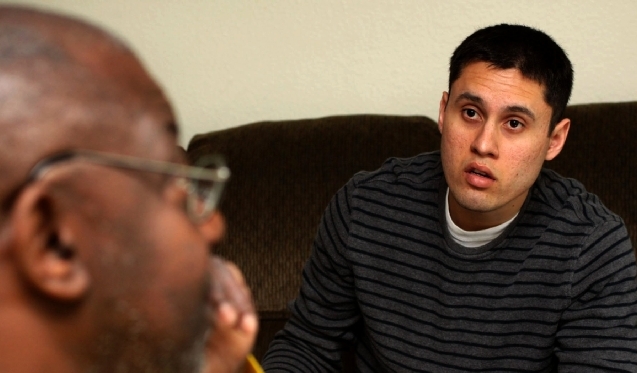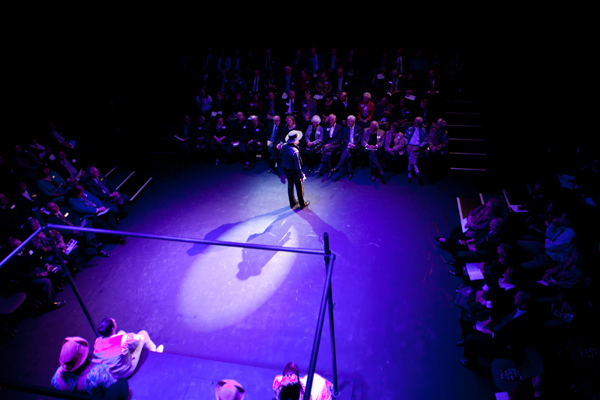Page 146 • (1,470 results in 0.088 seconds)
-
in my HISP 301 class last semester that were enrolled in the School of Nursing. And I was thinking about the importance of studying narratives, and how important it can be in the field of healthcare. When you talk to a patient, how do they communicate their ailments? Like, how do they tell you what happened? How did they get hurt? What is the reason that they’re here, what happened? What happens, then, is that the patient starts weaving a narrative. “Well I was doing this… and then this happened
-

voluntarily.”When PLU senior Kelsey Carlson gave Elaine Streich (pictured, left) a call two years ago after Streich had had a valve replacement, Carlson was surprised, but game. For all intents and purposes, Streich, 63, was trapped in her house. Her husband did all the shopping, attended social events for the pair and even had to help Streich, who lives in Tacoma, tie her shoes. Streich was struggling with the idea NOT drinking too much liquid in her daily diet, and dealing with chronic diabetes. The
-

of a transition period for a growing theatre program. What is your favorite class to teach and why? Introduction to Theatre. I love taking 40+ first year students under my wing. I not only love exploring why theatre is an essential component of democratic discourse, but I also love teaching students the essentials they are going to need to be successful students at PLU.What do you hope your students take away from your classes? That learning requires constant, imperfect practice. You need to
-
August 4, 2010 2010 PLU Athletic Hall of Fame THE 2010 PACIFIC LUTHERAN ATHLETIC HALL OF FAME CLASS, consisting of three national championship teams and three outstanding athletes who wore the black and gold, will be the 21st in the hall’s history. The list of inductees includes the NAIA national championship women’s soccer teams of 1988, 1989 and 1991; Jason Thiel (football, and track and field); Mike Simmons (men’s swimming); and Ted Carlson (men’s tennis). The induction dinner is scheduled
-

of a transition period for a growing theatre program. What is your favorite class to teach and why? Introduction to Theatre. I love taking 40+ first year students under my wing. I not only love exploring why theatre is an essential component of democratic discourse, but I also love teaching students the essentials they are going to need to be successful students at PLU.What do you hope your students take away from your classes? That learning requires constant, imperfect practice. You need to
-

this much fun can really get you college credit. Twyfelfontein, Namibia February 5, 20232nd Place Noah Dunham “Lunch Break” This photo encapsulates how it felt to eat lunch that day in the mountains of Norway for our second class trip. Quite oddly enough, it was also my 21st birthday – it had me thinking what I could have possibly done to receive a blizzard on my birthday?! Yet, now I feel that I almost miss this cold experience… but my toes sure don’t! Haukeli Mts, Norway February 23, 20233rd
-
about what it took to make the whaling vessel and what it means to hunt an animal that they revere, respect and was so important for their people’s survival for many years. “And they want to share and they will keep sharing as long as you give them an ear.” As open and honest as the Makah are, the students were well prepared to take a chance and ask questions without feeling timid. Class time before the students went to Neah Bay was dedicated to what Huelsbeck calls “Making it safe to take the risk
-

, their children Arne Ness ’69 and Cindy Ness, as well as grandson Shane Ness ’99. The Eastvold renovation project has been a decades-long effort. Hundreds of donors – including many through class reunion gifts – have contributed to the project. Fundraising continues for naming spaces and theater seats and for contributing to the Chapel Builders fund. Student Scholarship Support Campaign support to help ensure access for all students regardless of financial need came in two forms: annual support and
-

of North America’s indigenous populations even as she’s learning those of Latin America. “One of the biggest challenges for me designing this class … is I had to figure out which U.S. and Canadian native authors have been translated into Spanish,” Call said. “It was really interesting to see that some people that I think of as being very central to U.S.-based Native literature studies have not been translated at all.” Call will return to Colombia twice more as part of her Fulbright’s flexible
-

works. I mainly try to incorporate her take on skin. There is little to no blending of the colors, creating harsh transitions. However, like my posters, from far away they seem blended, it is not until you approach them that you see the color separation.Cris Haake BIO After taking a protracted break from university to get married and have a family, I returned to school in the fall of 2013 to pursue a second career. While I had limited exposure to art classes growing up (one semester-long class
Do you have any feedback for us? If so, feel free to use our Feedback Form.


